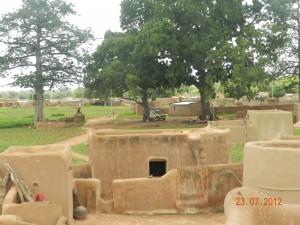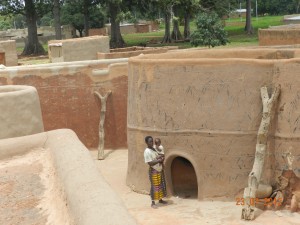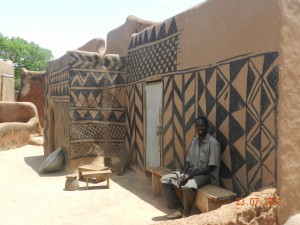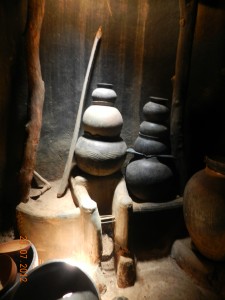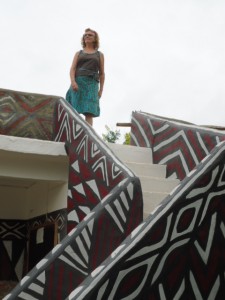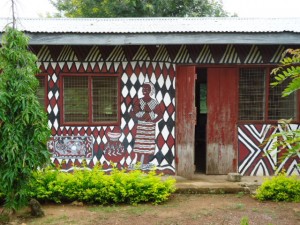for about 20 minutes until we arrived at the Nazinga River, which normally one just drives through. However, it had swollen its banks and was about 100 yards wide where the track went in.  I waded in to check the depth, egged on by an audience of local teenagers who kept saying “ca peut aller” (it can go). Clearly for them this was a spectator sport.
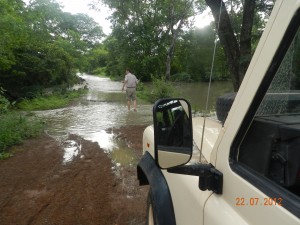
Wading in to assess crossability. It may not be clear here, but that is water as far ahead as you can see, and more water off to the right
One of the older boys said “il y a un trou” (there is a hole) and that there was another route upriver where they had put in some boards to help the crossing. If we had had a couple more hours of daylight I might have tried it but there was quite a current and it was getting late so we decided that discretion was the better part of valour, swallowed our pride and turned around, much to the chagrin of the boys. The fact was that we were just looking for a place to camp for the night and there was no reason for us to risk having the Landy swept downriver.  We retraced our route through down the wet track and found a nice place to camp on higher ground to pass a very pleasant night.
At Nazinga we were only about 40 kms from the border, but before we left Burkina we took a detour east to the village of Tiebele where the Gournonsi practice of decorating the outside of the mud houses with painted geometric patterns is still evident.  Despite the poverty Tiebele almost felt touristy as we were flagged by prospective guides. There is no system for assigning guides, you get the one that you decide to stop for, but once you have chosen one it seem the rest leave you alone.
We were taken to a complex of mud houses that are apparently the residence of the Chief and his family, the guide said some 80 people lives within the walls. It was a bit more refined than houses we have seen elswhere with some very unique features.
We did get a sense that maybe this was more of a museum than an actual house, it seemed too neat and clean. There were some people around, and women on the roofs stirring grains as they dried in the sunshine, but the place felt like it might be more a place to show the tourists than an actual chief’s compound.  However that did not detract from the very unique structure, which had many features we had not seen in other villages we have visited.
We could see plenty of other similar structures around, it is much less disruptive that they have one they can take the tourists to without disturbing people. That is just good community tourism management.  In the Tata Somba houses we went to in Benin and Togo we had to pay a tip to people whose houses we visited, which was a bit awkward.
On our way out of Tiebele we stopped at the local pump to fill up our 20 litre wash water jerry can. We paid  the Village Water Committee 200 CFA (50 cents) for the water, and another 200 CFA 50 to the fellow who lugged the full water can back to the vehicle.
Our objective that night was Sirigu in Ghana,which is about 60 km from Tiebele by road through the border crossing but probably only about half that as the crow flies. We spent the last of our CFA on diesel at the last filling station in Burkina at Po before we crossed the border. Then after crossing the border, just as we were clearing  Customs on the Ghana side, the last of all the check points on both sides of the border, we realized that the filling station we had stopped at in Po an hour earlier had not put the gas cap back on. As it is a locking tank it meant a full set of our keys was also still in Burkina Faso. Fortunately, officials in both countries were prepared to pretend we were still in Ghana while we quickly drove back to Po to pick up the keys and cap and waved us back through when we came back 20 minutes later.  I don’t think they would do that at the US-Canada border, but then they probably would not have forgotten to put the gas cap back on either.
We arrived in Sirigu about 5 PM, about 20 km in down a laterite road from the highway. En route via the laterite side road we were pulled over by a Ghana Immigration crew that were clearly driven by pecuniary motives, and were none too pleasant about it. They asked why were going to Sirigu and laughed when we said we were going to visit the Women’s Co-op. “Ohhh, going for a visit are you?”  It was almost funny to see their reaction when they realized that we had diplomatic passports and the Land Rover they had surrounded to hassle had diplomatic plates. They apologized profusely for bothering us and let us move on, but left us with an impression that the Ghana Immigration Service is not the most professional of organizations.
Sirigu and the surrounding region is also known for decorative painting of the houses. There is a strong women’s co-operative in Sirigu that runs workshops and a guest house with a lovely grounds where we were able to camp for the night. There was a Dutch man staying there who had taken workshops in pottery and basket-making, and an  American woman doing research in the region for her Masters thesis in Art History.  A pump on the grounds was visited by a steady stream of locals, mostly children, picking up water.  As the co-op facilities are themselves painted in the local style we did not have to go anywhere to see it up close.
Sirigu more modern and refined than what we saw in Tiebele, but does not convey the historical sense.   We visited the co-op shop in the morning and were on our way to Bolgatanga by 10:00 AM.
PS. A systems note:  We have now put on more than 5,000 km on the Defender in the month we have been on the road. Everything is working well. The early charging problems we had with the second battery have disappeared and there is no longer any loss of coolant. Incredibly, there is also no appreciable oil consumption – we have used less than a half litre of since we left Accra. Even the air conditioning, for which I thought it was only a matter of time before something failed, is performing perfectly.  We did discover an interesting electrical glitch related to the faulty hazard light switch that is the stuff Land Rover folklore is made of. I had discovered sometime before we left Accra that if I turned the ignition off when the flashers were on the motor keeps running.  It was explained to me by Eric our electrician that the hazard switch overides other systems and that this can happen if the switch is faulty.  Replacing said switch did not make the cut when determinng the priority things to do before we left. We discovered a new twist on the switch problem one day near Sindou when our stereo suddenly stopped working. I thought it was simply a fuse and on inspection found that indeed there was a fuse that was blown that could have been the problem. We were still looking for a place in Banfora to buy a fuse from when we put the flasher on to turn around and the stereo suddenly started working again. We subsequently learned it was just a matter of playing with the hazard switch until the radio comes on, then it stays on, at least until we go into reverse gear, which for some bizarre reason knocks the stereo off again.  I am not making this up.  Apart from that rather humorous glitch, and a slow leak in a rear tire that needs attention, everything is humming.
